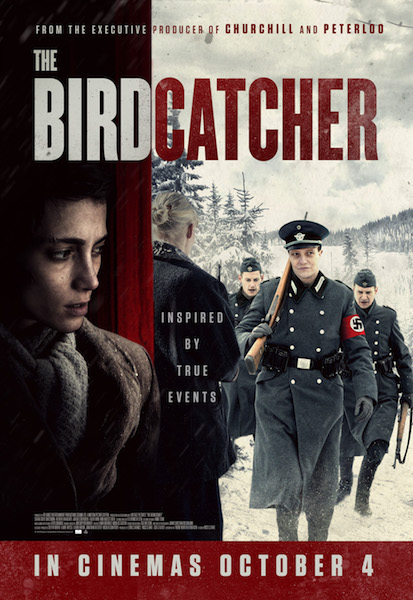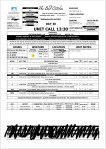
It was touch and go some 30+ years ago, when at art college, should I work in the film industry, or, should I work on still photography I thought?
I was a huge film buff, still am. I consume movies at an alarming rate, especially when in travel. There have been times over the past three decades when I wondered had I made the right decision?
Deep down, I knew I had, especially when I managed to merge my love for sport with photography and writing.
It was running and working on races that introduced me to Leon Clarance, a successful film producer. We hit it off and I was fortunate to photograph Leon at races such as Marathon des Sables and Everest Trail Race. We often discussed film and he knew I was a film fan.
A conversation over a beer one day and I told Leon, that one day, I’d love to shoot a film. It was a casual throw away conversation as we discussed each other’s work.
Well, Ross Clarke, the director of The Bird Catcher, produced by Ross, Leon and Lisa G Black, noticed one of my images of Leon from a race. He liked the look and style of the imagery and this opened the door to work on The Bird Catcher.

Leon Clarance on set in Norway.
The Bird Catcher is a truly amazing story with a stunning cast:
Sarah-Sofie Boussnina, August Diehl, Laura Birn, Arthur Hakalahti, Jakob Cedergren and Johannes Bah Kuhnke amongst others.

Sarah-Sofie Boussnina – A rising star who gained recognition for ‘The Bridge’ TV series and Knightfall, Black Lake and recently Mary Magdalene.

August Diehl on set in Norway. August is primarily known for playing Dieter Hellstrom in Tarantino’s ‘Inglorious Basterds.’
Directed by Ross Clarke (Skid Row, Heroes & Demons, Dermaphoria) the movie tells the story of a young woman (Sarah-Sofie Boussnina) in Norway who flees the Nazi roundup and conceals her identity whilst working on an occupied farm.
Inspired by harrowing true events. This gripping new thriller uncovers a hidden slice of World War II history that is as shocking as it is inspiring. Norway, 1942. During her attempt to flee Nazi persecution, 14-year-old Jewish girl Esther finds herself alone and forced to conceal her identity on a Nazi sympathiser farm. Forced to make a series of choices, her actions shift the paths of those around her. From collaboration to resistance, the population’s reaction to their Nazi conquerors was not always clear-cut.

Director – Ross Clarke
Jon Christian Rosenlund was the DOP (Director of Photography) who has worked on movies such as, The Wave, Thousand Times Good Night, The Kings Choice and so many more! He is a true master of his craft and to see him in action with a dedicated crew was a pleasure. He has a wonderful vision and his lighting approach – stunning.

Director of Photography – Jon Christian Rosenlund – On set at The Farm in Norway.
MY ROLE
I was commissioned for two shoots, both on location in Norway, at different time points so as to capture still imagery that would best illustrate the story.
In principal, I had two briefs:
1. Capture still imagery of the movie – the scenes, the actors, the locations and help tell a visual story.
2. Capture behind the scene moments that tell the story of how a film is made.
A TYPICAL DAY
Movies are long, arduous and harsh. Especially when working in Norway with sub zero temperatures, snow and ice. Film sets are very controlled and costly. Therefore, everyone has a role and each day is planned to precision and a storyboard rules the day with a set of objectives.
Lighting, camera angles and planning is done in advance of the movie so that that film crew can work ahead of the DOP and have scenes ready for ‘action’ asap.
Actors, make-up, wardrobe, props and so on, equally are all planned in minute detail.
Controlling the running of everything are the producers and director. The director controls the film’s content and creative style and the producers make sure the film is on time and on budget – I simplify the roles. Both producer and director work well in advance of any film with script, writing, planning, financing and so on. Post the film process, attention then turns to editing and releasing the film.

Jon Are Uhnger
Jon Are Uhnger (1st AD) each morning would assemble all crew and brief them with a ‘UNIT CALL’ of the day’s schedule.

This is ‘The Bible’ for each day and specifies everything that is needed for the day – for example Day 30 below:
Starts with a 13:30 call and a 22:45 finish.
It specifies shooting scenes, allowed time, set description, required people, what actors and so on. It needs to be managed down to the minute and there is a constant level of pressure for all involved.
WORKING ON A MOVIE

I was told that the lowest of the low on a film set is the stills shooter. So, I was a little nervous being a rookie on a film set. However, Leon reassured me that Ross and Jon were cool guys.
And they were. A complete and utter pleasure to work with.

Noise, distraction, being in the wrong place at the wrong time are all things, amongst others, that will make you very unpopular on a film. It’s very much a case of don’t be seen and don’t be heard.
Usually, a stills photographer will move in after a scene has been successfully filmed and capture stills by re-creating key moments. The main reason for this is complicated but in summary:
1. Cameras make a noise when you take a photo.
2. You can be a distraction if moving whilst filming.
Gladly I had recently converted from using Canon cameras to Sony. The Sony cameras are mirrorless and key for the film industry, have a ‘silent’ mode. This proved to be crucial and in advance of the movie, I had already expanded and planned my equipment with the intention of shooting whilst they filmed. This was in someway, looking back, a risky decision. However, I was committed that shooting ‘live’ would give me the best imagery.


Day 1 I was really nervous as we went straight into a very intense scene with German soldiers, Sarah-Sofie Boussnina pulling a sledge and the arrival of a motorbike. I treated it, looking back, like a race. I planned my angles, shot live and caught the action as it happened. I was in my element. Buzzing would be an underestimation.

Post the filming, I moved in for a couple of close-ups while the crew re-set for the next scene and I then captured images of the crew working and setting up.


This process was repeated throughout the day as we all worked to the day’s schedule. At all times I was conscious of the films camera angle, the lens focal length, the story, the emotion and looking to capture what would be the essence of the film.



I can honestly say, I have been very fortunate to work on amazing photography projects in my career, and now, looking back, The Bird Catcher is without doubt one of the highlights. It was challenging, stressful, rewarding, eye opening and just the most remarkable journey.
At the end of day 1, I was editing photos. I had that buzz of excitement knowing I had captured some really strong imagery that really reflected what I had seen being filmed. Ross and Jon looked over my shoulder and then asked to look… I am sure I stopped breathing for a short while. Were they not happy?



I opened the images and scrolled through, one-by-one!
‘When did you take these images?’ Jon enquired.
’I shot most of them while you were filming,’ I replied.
’Not possible,’ he said. ‘You can’t shoot when we are… But these images are stunning!’
I could have fainted. I explained about my camera, shooting silent and wanting to capture in ‘real’ time.
Jon replied, ‘I want to see that camera…’





From that moment on, I was respected on set. Given the space I needed and allowed to shoot with relative autonomy. Once or twice I pushed the boundaries, trying to get the best shot and I was warned accordingly. But the results were the secret, Jon, Ross and the team could see the difference.






Over the shooting days we had multiple locations, challenging scenes, different light and the whole process was a whirlwind of adrenaline. I may have been working, but it felt like I was in a movie living out a dream.
There was an intensity on set. The story of The Bird Catcher is one that should be told and some scenes, quite literally had the crew in tears. Each scene, I thought to myself, I cannot wait to see this movie. At the end of each day we would see dailies, but they are just jigsaw pieces.



It has been over 2 years since working in Norway and the content I produced could not be shown… The Bird Catcher finally has a UK release on October 4th and now I can tell my story.

I urge you to see this movie!
Cinema is a wonderful medium. Working behind the scenes has not burst the bubble or shattered my illusions, on the contrary, it has enhanced my experience.
I made new friends in Norway and I witnessed a film crew working as one to tell the story of The Bird Catcher, because, the story needs to be told!


Sarah-Sofie Boussnina and Arthur Hakalahti are without doubt, the stars and they have already gained worldwide recognition for their skills as actors, The Bird Catcher will only enhance that.
Ross, Leon and Lisa have produced something very special and Jon has given it all a wonderful sumptuous and at times harrowing look. It’s a piece of art.
I hate to single out people as a film is all about everyone coming together and working to one objective, the initial reviews confirm that they all did a great job.


The backdrop produces stunning winter images of coastal Norway near the Swedish border. The snow-frosted forests and idyllic countryside provide a nice juxtaposition to the suspense and fear the characters experience. The audience provided several audible gasps through every twist and turn in the plot. – Edhat.com



